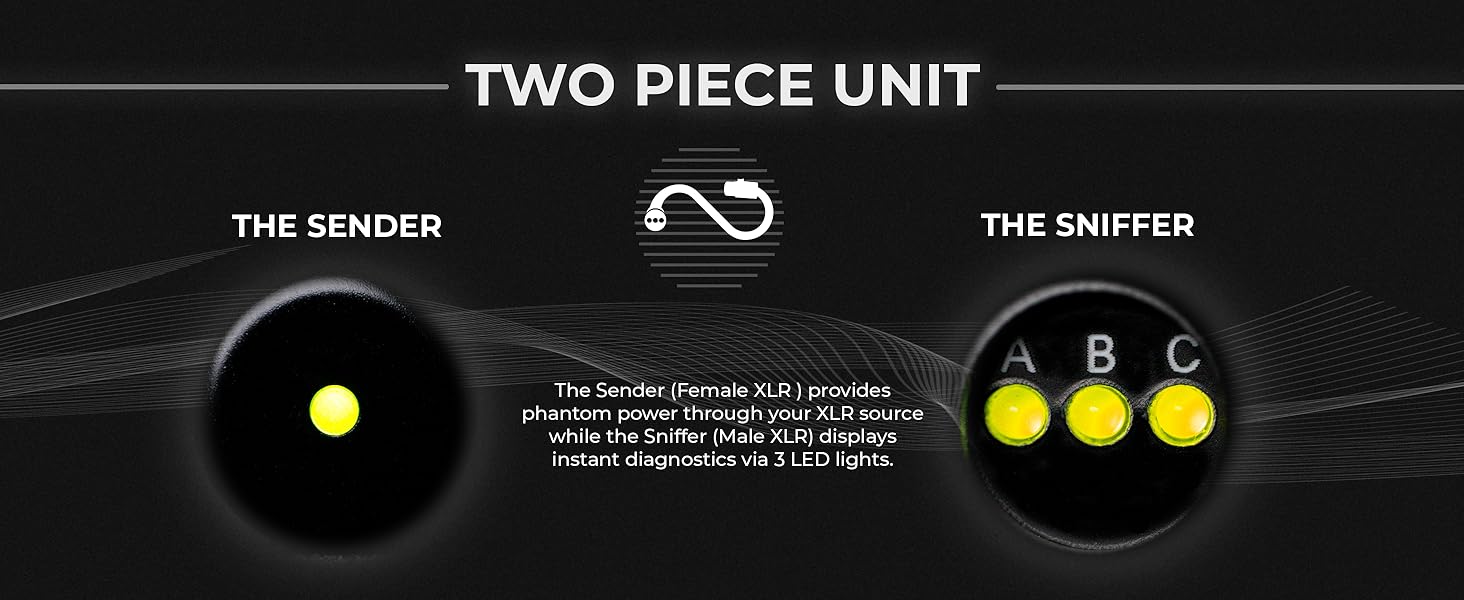






🎤 Diagnose like a pro, fix like a boss.
The SoundTools XLR Sniffer/Sender is a compact, durable two-piece cable tester designed for professional audio engineers. It instantly diagnoses XLR, DMX, and NL4 cable faults with intuitive LED indicators, supports rapid testing of 50+ audio channels via phantom power, and features a rugged aluminum build powered by a long-lasting A23 battery—making it an essential tool for live and studio sound troubleshooting.



| Package Dimensions | 4.37 x 3.03 x 1.61 inches |
| Item Weight | 0.32 ounces |
| Manufacturer | Sound Tools |
| ASIN | B00C0NTSUS |
| Item model number | XLR Sniffer/Sender |
| Batteries | 1 Nonstandard Battery batteries required. (included) |
| Is Discontinued By Manufacturer | No |
| Date First Available | July 30, 2013 |
J**B
A professional tool for anyone who cares like a pro
I have been working in show production for over 20 years. I have seen gadgets and tools come and go that are supposed to make the live of an audio technician or engineer "easier" or to attempt to make a stagehand's job better. Most of these fall totally flat, designed by people who don't get what we do for a living.NOT this one.To fill people in who may not know: Rat Sound is a production company founded by the legendary Dave Rat who knew that audio technicians and engineers have the difficult task of making technology work for artists with zero time and even less resources. The company not only provides audio and FOH (front of house) solutions for some of the word's biggest shows, but also the crew to run them. He gets what stage hands, technicians and engineers need.The Rat Sniffer is perhaps the most clever tool I have ever owned since the Gerber 600 multi tool (Yes, I am a "Gerber" and not a "Leatherman" kind of person). It does one thing: Tests if XLR cables are good, and what is wrong with them when they go bad. It has 4 lights. One on the back to let you know when one end of the device is providing 48V DC power (aka "Phantom Power"). The other end has 3 LED's that change from green to red depending on the state of the connection. The handy guide (which is now the perfect size to tape right on the device) tells you what the combination of red and green lights mean. This shows you which pins are active, and which are not. It may not seem like a big deal, but knowing what electricity is flowing through each pin on an XLR cable can mean the difference between payday and ticket refunds.And, this can do it. All. Day. Long.The concept is simple: Plug one end into the terminus (End point) of the cable. Then, either turn on Phantom power on your console, or if you are manually checking connections, plug the other end with the single LED in. Twist the bottom, and you have the answer on WHAT is wrong with a cable instantly! No meter probes. No guessing if there is power. And, if you have a large analog snake to check (aka a large wire loom with multiple XLR channels), you can pop this on or off with Phantom on the console and diagnose an entire 16 channel snake in less than a minute. No symbols to decipher. No wondering what the screen says in super bright or pitch black backstage areas.And, the beauty that it does this instantly. It is built out of all metal components, and the batteries are somewhat easy to find (although not as common as AA). Yet, you do not even need the other end if you have phantom power on the console you are using to check.It is one of those tools that is so simple it is genius, but yet it is executed nearly flawlessly. AND, it is the size of a thick Sharpie pen, which EVERY stagehand has (or should).Get it. Use it. Love it. It will pay for itself on the first gig. Seriously. This is where it is at.
F**Y
Great Cable Sniffer
Used one of these for years. Gave mine to a buddy and bought another one. Makes simple work of diagnosing an XLR which has been wrongly terminated. May have to work on an end a second time, but never a third.
J**H
Makes Life Easy
This is a must have tool for live audio engineer! Besides the great features, the build high quality, attention to detail, and even packaging quality surpassed my expectations and is top notch
P**Y
Excellent tool.
Does as advertized
D**S
I AM STUPID
As a tech for over 20 years in AV, I cant believe I have not had one of these since now. This came on Wednesday, and I used it on Thursday at a huge old church where the soundboard is 3 levels up and its Sandford and Son every nook and cranny. Thy never threw anything away in 50 years. Bad wire? Just leave it! So, they have an Easter Play coming up and have 2 small identical snakes on stage feeding a large 32ch snake behind the stage which runs to FOH. Nothing labeled anywhere. Total nightmare. I needed to find 4 channels to add Lavs for the play so I went up to the FOH, used this device on the first open channel on the snake, went down to the stage, and found the first wire in 30 seconds. All 3 pins working! 10 minutes later I had all 4 channels patched. There jaws were on the floor as they haven't been able to patch anything in the nightmare. WOW. Super happy, great little case to carry around my new prized possession. Thank you for making me more pro.
E**N
Works perfectly
Very helpful to have in my bag, test cables before they go out.
P**T
Nice yet flawed tool
The "XLR Sniffer/Sender" by SoundTools is just the ticket if you do a lot of work using microphone (or other) cables that have 3-pin XLR connectors on the ends. One of the most frustrating aspects of running cables, setting up microphones, testing them, and troubleshooting the whole setup is trying to get to the bottom of cable faults. Is it the cable, the phantom power coming from the preamp/mixer, or is it the microphone itself? And if it is the cable, then what is the fault?There are quite a few XLR cable testers on the market, but most are fairly large and/or expensive. This sniffer/sender is the smallest I have found that actually works well enough to have readily apparent utility. It is also comparatively inexpensive.The tool consists of two parts, the so-called 'SENDER' and the the 'SNIFFER'.The SENDER is is an aluminum tube with a black anodized finish. It measures 4" long by about 3/4" diameter. On one end it has a female XLR connector, on the other end it has a recessed on/off power button-switch that lights up green when ON, and inside is an A23 type 12V alkaline battery, as often used in remote controls for automobile remote starters and garage door openers. Note that even if the power switch is ON, it will only light up if the SENDER is plugged into a cable with the SNIFFER or a microphone at the other end. The higher battery voltage is needed since this sender is basically a phantom power supply. It can even be used by itself to power microphones if you connect it to the mic using a Y-cord. In the case of this tool, its primary purpose is to energize one end of the cable being tested so that the SNIFFER can to its job at the other end of the cable. But if the cable under test is already plugged into a phantom power source, you don't need to use the SENDER.The SNIFFER is the actual tester. It is also a black anodized aluminum tube, in this case with a male XLR connector at one end and a set of three small LED lamps at the other end; as with the SENDER's recessed power button, the SNIFFER's LEDs are recessed to protect them. The SNIFFER measures 2-3/4" long and has the same diameter as the SENDER. The LEDs are labeled A, B, C, and they have no direct correlation to the three pins of the XLR connector or associated cable. Instead, you need to use a chart to figure what the LED patterns are trying to tell you about the cable under test. The tool comes with a good quality color label that has an adhesive backing, and it may be applied to the SNIFFER by wrapping around the tube, or it may be placed on some other object or stuck inside your tool case, etc. I found that since the label has a thin white border on an otherwise black label, and since the SNIFFER has a black finish, I wanted to take a scissors and trim away the white border before applying the label to the SNIFFER...it looks much better that way.The SNIFFER can be used without the SENDER if the cable under test is plugged into a working phantom power source, such as a microphone preamp or mixer. You can quickly check out a given cable, or test a series of cables within a snake cable. You can use it to check integrity of the cables' wires, soldered connections, or the XLR connectors themselves, and you can use it to verify proper phantom power on the cable.The SNIFFER uses eight LED patterns, and they refer to nine cable faults. The LEDs can light up either green or red (if you happen to install the SENDER battery backwards, the SNIFFER still works but the red/green patterns are reversed in color). If all three LEDs are on with a green color, then the cable and its connectors are good and the phantom power is good (of course, if you have the SENDER at the other end, then you are testing only the cable, not the phantom power). Besides the all-green LED status ("All green, cable is clean"), the other eight patterns will make no sense without the included chart. Examples:A=off, B=off, C=off means that pin 1 is openA=on green, B=off, C=on green means that pin 2 is openA=on red, B=on green, C=off means that pin 3 is openThe same LED pattern is used for 'pins 1 & 2 swapped' and also used for 'pins 1 & 2 shorted'. Likewise 'pins 2 & 3 swapped' and 'pins 2 & 3 shorted' share a pattern. The other indicated faults each have dedicated LED patterns.I tested all possible cable faults using a test fixture that I whipped up for the purpose. It allowed me to quickly simulate an XLR cable connected correctly and also with all possible opens, shorts, and swaps. In doing this, it became apparent that the SNIFFER cannot tell you ALL possible cable faults. It is designed for faults that are probable, but not catastrophic. For example, it will indicate any TWO shorted pins, but if all THREE pins are shorted you will get the same LED pattern that the chart says means 'pin 1 open', and for that matter you get this pattern if you unplug the SNIFFER from the cable, or just turn phantom power (or the SENDER) off. But in realistic situations, the patterns are adequate do detect and indicate likely cable faults.I like the basic utility of this product, and it has a nice solid construction that looks like it will hold up very well under heavy use.I do have a couple gripes with this product. One is that, in my opinion, the LED pattern with all three LEDs being off should have been reserved for a disconnected condition (or phantom power off), and NOT used to indicate 'pin 1 open'. Another is that, while all but one LED pattern gives good LED brightness, one particular pattern (for 'pin 3 open') gives LED 'A' as a very dim red. I thought my SNIFFER must have been faulty, so I contacted SoundTools and let them know. They replaced the SNIFFER but that replacement also has the same very dim LED. The same LED is bright red or bright green in other patterns, so I attribute this issue not to a bad LED but rather to a poor design in this instance.Indeed, the apparent randomness of the LED patterns relative to what they mean suggests to me that when this tool was designed, somebody just started hooking up LEDs in various arrays until they got patterns for most faults and then never really finished, or refined, the design. But I don't want to be too hard on them; at this prince point, and with such a small device, it is not practical to have a much more sophisticated design. In a perfect world, the SNIFFER could have its own power supply and a small logic circuit or even a tiny microprocessor, and it would do all sorts of things with the LEDs to show all possible faults without needing to refer to a chart. But that is not what this tool is, and I don't think the designers intended that level of functionality. They intended a small, sturdy and inexpensive cable tester and that is what they produced. I would have rated this more highly except for the issue of the dim red LED mentioned above; they should have worked this design some more to avoid this situation, or at least indicated on the chart that a dim LED is expected in that case.
G**A
herramienta que todo tecnico de sonido deberia tener
es una. herramienta que todo tecnico de audio debería tener como parte de su equipo, la entrega fuera rapida y segura y estoy muy contento
Trustpilot
2 weeks ago
3 weeks ago
1 week ago
1 month ago